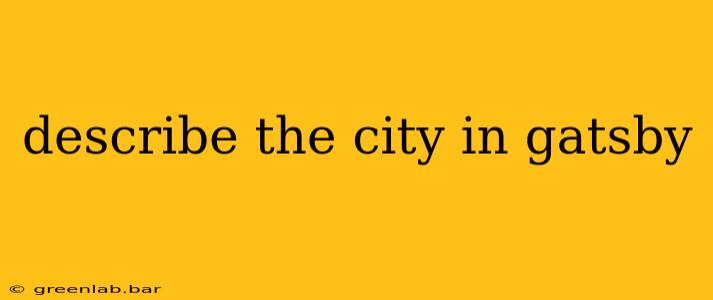F. Scott Fitzgerald's The Great Gatsby isn't just a love story; it's a poignant critique of the roaring twenties, masterfully woven into the very fabric of its setting: West Egg, East Egg, and the surrounding Long Island landscape. The city, while not the central focus, acts as a powerful backdrop, subtly shaping the characters and their tragic fates. This essay will delve into the city's multifaceted role, exploring its symbolism and its contribution to the novel's enduring power.
The Dual Nature of Long Island: West Egg vs. East Egg
The novel's geography is meticulously crafted to reflect the stark social divisions of the era. West Egg, Gatsby's residence, represents the "new money" – those who have amassed their fortunes through recent, often questionable, means. It's a place of ostentatious displays of wealth, gaudy mansions, and a certain lack of refinement. Gatsby's lavish parties, overflowing with uninvited guests, epitomize this chaotic energy. The houses, while grand, lack the established elegance and history of their counterparts across the bay.
Conversely, East Egg, home to the established wealthy like Tom and Daisy Buchanan, symbolizes "old money." Here, wealth is inherited, ingrained in family history and tradition. The houses are subtly more refined, reflecting a sense of established power and understated elegance. The social interactions are more controlled, the air thick with unspoken rules and ingrained prejudices. The contrast between the two Eggs highlights the inherent class divisions and the unattainable nature of true social acceptance for Gatsby, despite his wealth.
The City as a Stage for Illusion and Deception
The city, encompassing both Eggs and the wider Long Island landscape, provides a stage for the elaborate illusions and deceptions that permeate the novel. Gatsby's meticulously constructed persona, his grand parties, and his relentless pursuit of Daisy are all played out against this backdrop. The glittering surface of wealth and social success masks a deeper emptiness and despair. The city becomes a symbol of the American Dream's corruption, where the pursuit of wealth often leads to moral compromise and ultimately, disillusionment.
The Valley of Ashes: A Bleak Counterpoint
The Valley of Ashes, a desolate wasteland between West Egg and New York City, serves as a powerful counterpoint to the glittering wealth of the Eggs. This industrial dumping ground, choked with ash and symbolic of the moral decay lurking beneath the surface of the Jazz Age, underscores the harsh realities ignored by the wealthy elite. It's a stark reminder of the human cost of unchecked industrialization and social inequality. The desolate landscape mirrors the spiritual emptiness of many characters, particularly George Wilson, whose life is crushed under the weight of societal neglect.
New York City: The Heart of Moral Ambiguity
While not extensively described, New York City's presence is felt throughout the novel. It represents the epicenter of the era's moral ambiguity, a place where ambition and desire intertwine with deceit and corruption. Tom's infidelity and his casual cruelty are played out both in the city and on Long Island, demonstrating how the city's atmosphere permeates even the seemingly idyllic suburban settings. The city acts as a symbol of the intoxicating yet ultimately destructive nature of unchecked ambition and the pursuit of pleasure without consequence.
Conclusion: A Lasting Legacy
The city in The Great Gatsby is far more than just a setting; it's a crucial element in the novel's thematic richness. Fitzgerald's masterful use of geography creates a powerful contrast between illusion and reality, wealth and poverty, old money and new. The enduring power of the novel lies in its ability to capture the complexities of the Jazz Age, using the city as a canvas to paint a vivid and ultimately tragic portrait of a society grappling with its own excesses. The city, therefore, remains an integral part of the novel's enduring legacy, a potent symbol of the American Dream's allure and its often devastating consequences.

